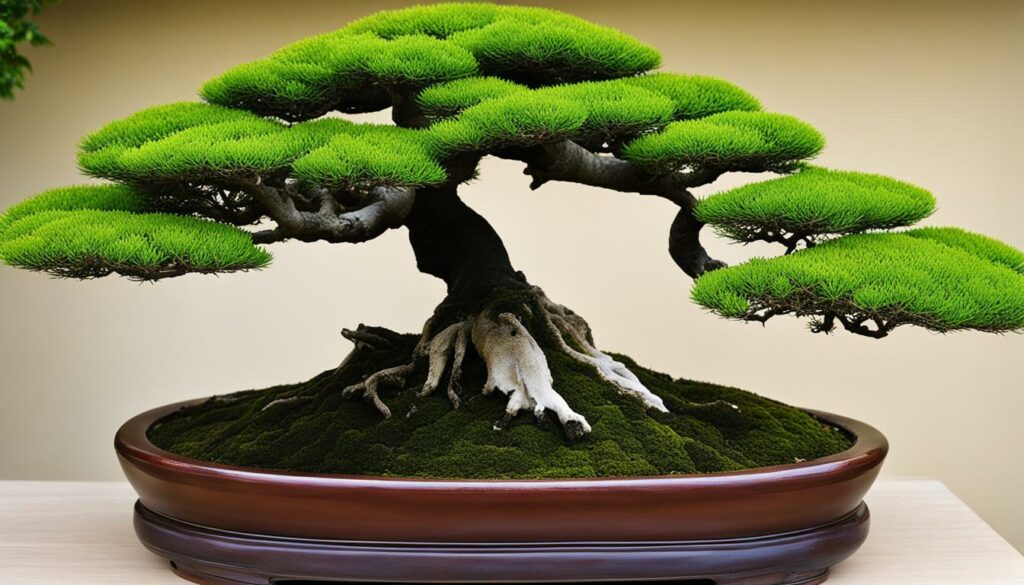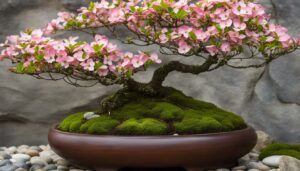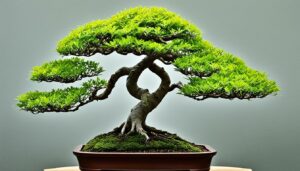If you’ve ever marveled at the intricate beauty of bonsai trees, you know that cultivating these miniature tree varieties goes beyond mere gardening—it’s an art form steeped in tradition and precision. A pivotal aspect of nurturing these living sculptures is bonsai tree species identification. Understanding the subtleties of various species can enhance your bonsai journey, as each type possesses its unique growth patterns, leaf shapes, and care requirements.
Accurate identification of bonsai tree species is not only the foundation for providing appropriate care but also for appreciating the diverse range of styles and expressions found in these horticultural masterpieces. With the right knowledge and tips, you’ll be well-equipped to identify, cultivate, and showcase these splendid miniaturized representations of nature.
Key Takeaways
- Identifying bonsai tree species is crucial for their proper cultivation and styling.
- Each bonsai variety has specific care needs such as pruning, watering, and sunlight exposure.
- Mastering identification deepens your understanding and appreciation of bonsai artistry.
- Recognizing different miniature tree varieties allows for more refined and artistic cultivation.
- Learning the characteristics of bonsai species ensures the health and longevity of your trees.
- Species identification enriches the cultural experience of bonsai cultivation.
The Art and Importance of Identifying Bonsai Trees
Embarking on the journey to master identifying bonsai trees is not only about honing your skills but also about immersing yourself in the art of bonsai. In this practice, each miniature tree presents its a unique identity, which informs crucial care decisions. Your ability to distinguish between species is the cornerstone of providing tailored watering, feeding, and pruning—a commitment that ensures the thriving beauty of these living sculptures.
As you develop your bonsai identification skills, you cultivate an eye for the nuanced distinctions in leaf shape, bark texture, and overall growth habits. Recognizing the subtle differences opens up a dialogue with your bonsai, allowing you to respond to its individual needs effectively. This attentiveness not only nurtures the tree’s health but also enhances its aesthetic appeal, affirming your role as an artist in the bonsai community.
- Studying leaf size and color
- Observing the bark and trunk structures
- Understanding the growth patterns and seasonal changes
- Note taking from bonsai care books and expert workshops
Consider the table below as a preliminary guide to recognizing some common bonsai traits:
| Bonsai Type | Leaf Characteristics | Bark Texture | Typical Pruning Season |
|---|---|---|---|
| Juniper | Needle-like, rich green | Stringy and fibrous | Late spring |
| Ficus | Broad, glossy leaves | Smooth with light tan coloring | Year-round, as needed |
| Maple | Deciduous, sharp-lobed leaves | Smooth with age developing rough texture | Late winter |
| Pine | Long, thin needles | Rugged with deep grooves | Autumn |
Your journey in the bonsai world will evolve as you refine these skills, leading to a deeper connection with the ancient art of bonsai. Remember, this is not simply about caretaking, but also about becoming an artist who portrays the essence of nature in miniature form.
Starting with the Basics: Bonsai Tree Anatomy
Delving into the fundamental aspects of bonsai tree anatomy is essential for any enthusiast eager to master the art of bonsai. Familiarizing yourself with the distinctive features of your bonsai, such as trunk and bark textures, leaf shapes, and understanding how to care for them through the seasons will enhance your ability to identify and nurture these living sculptures.
Understanding Trunk and Bark Textures
One of the most captivating characteristics of a bonsai tree is its trunk. The texture and patterns of bark can vary significantly from species to species—some exhibit smooth, almost silken bark, while others possess rough, deeply furrowed textures. Being able to identify these nuances is a telltale skill in bonsai identification. Take, for instance, an Azalea bonsai, which typically presents a sleek, reddish bark, contrasting with the rugged, plated bark of a Pine bonsai.
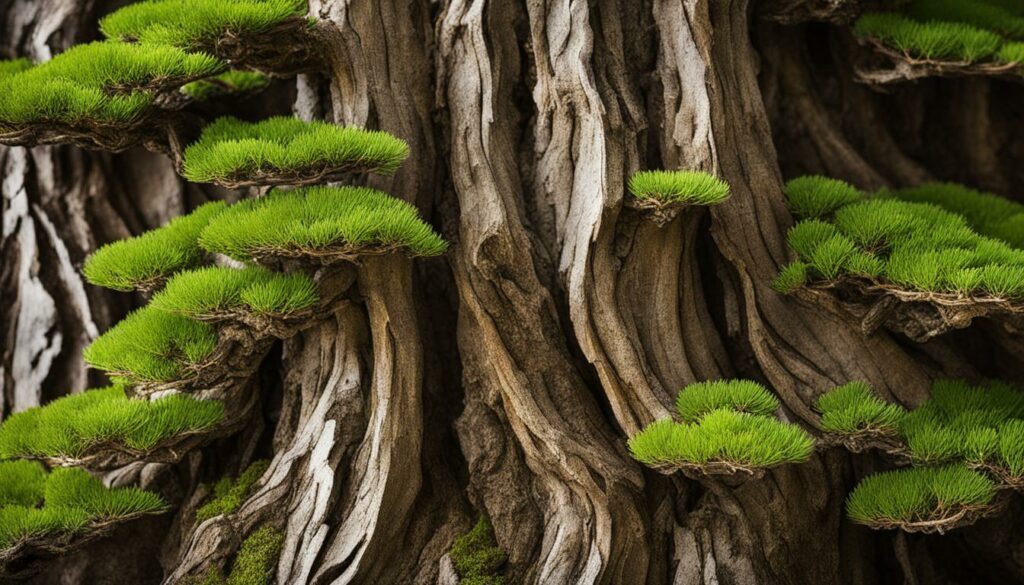
To help you understand the intricate variations in the bark of various bonsai species, a comparative study is invaluable:
| Bonsai Species | Trunk Texture | Trunk Coloration | Notable Characteristics |
|---|---|---|---|
| Azalea (Rhododendron) | Smooth and Glossy | Reddish-brown | Exfoliates with age |
| Pine (Pinus) | Rugged, Deep Furrows | Gray to Blackish-brown | Plated appearance, resinous |
| Maple (Acer) | Smooth with Age | Grayish | May show moss or lichen growth |
| Juniper (Juniperus) | Fibrous, Shredding | Gray to Brown | Fibers may peel in strips |
Leaf Shapes and Seasonal Changes
Bonsai trees are also renowned for their diverse leaf shapes, which is another crucial aspect of their anatomy for identification and care. From the needle-like foliage of conifers to the delicate broad leaves of deciduous varieties, each leaf shape dictates specific seasonal bonsai care needs. As seasons change, so do the leaves on many bonsai trees, requiring adjustments in watering, positioning, and feeding.
- Spring: Look out for new buds and adjust watering to accommodate increased growth.
- Summer: Protect leaves from harsh sunlight and maintain consistent moisture.
- Autumn: Prepare for leaf drop in deciduous varieties, and begin to reduce watering.
- Winter: Observe for cold damage, especially in tender leaf tips, and provide protection from frost.
Recognizing and responding to the unique needs of your bonsai’s leaves throughout the year not only ensures its health but also deepens your connection to the seasonal rhythms of these miniature trees.
A Guide to the Most Popular Bonsai Types
Embarking on the journey of cultivating bonsai can be both exhilarating and daunting. Whether you’re a seasoned aficionado or new to the bonsai world, familiarizing yourself with the most popular bonsai types is essential. This section of our bonsai species guide is dedicated to helping you in identifying bonsai trees that you will commonly encounter and their distinguishing features.
Let’s delve into the specific characteristics of these beloved bonsai varieties:
- Ficus Bonsai: Known for their versatility and ease of care, Ficus bonsai are a staple among enthusiasts. Pay attention to their glossy leaves and robust, aerial root systems.
- Juniper Bonsai: A quintessential bonsai choice famous for its lush, needle-like foliage and flexible branches, ideal for various styles.
- Maple Bonsai: Maple bonsai, particularly the Japanese Maple, are celebrated for their vibrant seasonal color changes and delicately shaped leaves.
Moreover, here’s a concise table that aligns popular bonsai types with their notable features:
| Species | Leaf Type | Unique Features | Care Level |
|---|---|---|---|
| Ficus | Broadleaf | Many varieties, aerial roots, tolerates low light | Beginner |
| Juniper | Coniferous | Needle-like leaves, hardy nature, great for shaping | Intermediate |
| Maple | Broadleaf | Deciduous, color-changing leaves, intricate branching | Advanced |
While these varieties might be prevalent in bonsai collections, each species still carries its unique set of requirements and aesthetic nuances. Remember that patience and ongoing learning will enhance your aptitude for identifying bonsai trees and caring for them.
Bonsai Tree Species Identification by Leaf Type
Embarking on the quest of bonsai tree species identification, you’ll soon discover that the foliage of your miniature trees holds vital clues. Each species of bonsai has its distinct bonsai leaf types which are key to species recognition. Whether your bonsai sports needle-like leaves typical of coniferous trees, or the varied broadleaf patterns seen in deciduous species, each characteristic serves as a botanical fingerprint.
Understanding the nuanced differences among leaf types will not only improve your identification skills but deepen your appreciation for the diversity within the bonsai world. And when you meticulously observe the leaves’ size, shape, and texture, you are engaging in a practice that connects you directly to nature’s subtle intricacies.
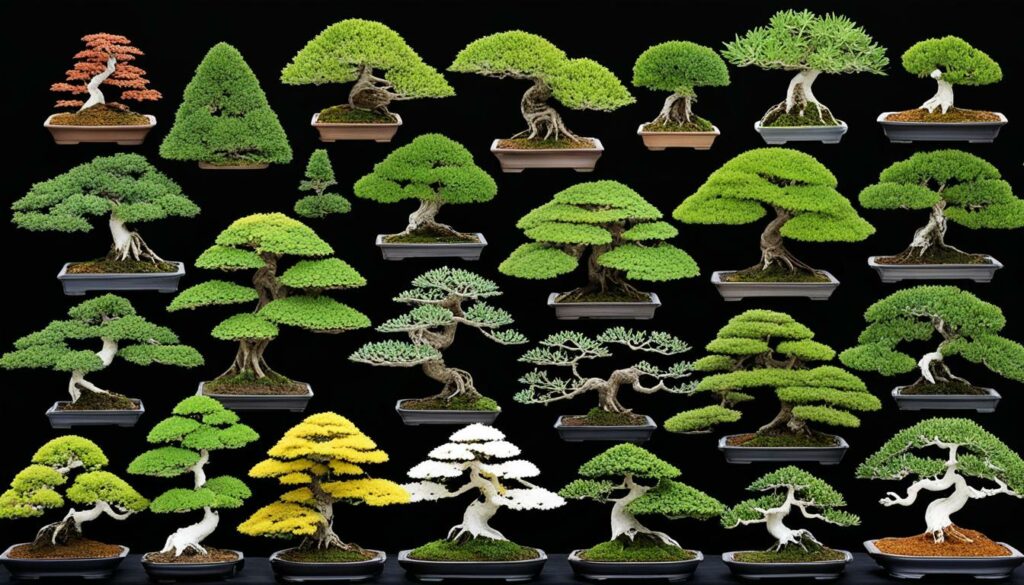
| Leaf Type | Description | Common Bonsai Species |
|---|---|---|
| Needle-like | Sharp, thin, and pointy leaves; often evergreen | Juniper, Pine, Spruce |
| Oval Broadleaf | Rounded shape with a consistent width | Ficus, Chinese Elm, Jade |
| Lobed Broadleaf | Edges of the leaf have distinctive protrusions | Maple, Oak, Zelkova |
| Compound | A collection of leaflets on a single stem | Chinese Pepper, Black Olive, Aralia |
Gazing upon your bonsai’s foliage, you may observe the whisper-thin needles of a Juniper which differs markedly from the fan-shaped leaves of a Ginkgo. This keen observation can guide you towards the correct species recognition, ensuring that each bonsai receives the specific care it necessitates.
So, as you journey through the art of bonsai, let the leaves be your guide. With patience and a discerning eye, bonsai tree species identification by leaf type becomes not just a task, but a path to a greater understanding of these living sculptures.
The Role of Flowers and Fruit in Species Recognition
As you delve deeper into the world of bonsai, you’ll discover that the bonsai flowers and bonsai fruit are not mere ornamental details but are key features in species recognition. Whether you are a novice grower or amassing a diverse collection, understanding the nuances of these features can lead to accurate identification of your bonsai’s species.
It’s fascinating to observe that the distinct characteristics of flowers and fruit can reveal much about the tree. Take, for example, the size and color of the blossom, or the timing of fruiting seasons—these are all vital clues that can assist you in discerning one species from another. Emphasizing flowers and fruit in species recognition not only enhances your skill but also allows you to appreciate the sheer variety and beauty of bonsai species.
- Flower Size & Color: Noting the hue and dimension of blooms can pinpoint specific varieties, as certain species exhibit unique coloration or flower sizes.
- Fruiting Patterns: The frequency and period of fruit-bearing times can provide insights into the bonsai’s identity; seasonal differences often reveal critical identification data.
- Seasonal Appearance: Observing when a bonsai tree flowers or bears fruit throughout the year can help in differentiating species that otherwise share similar foliage.
Considering these traits, enthusiasts can cultivate a discerning eye, enhancing their enjoyment and expertise of bonsai growing. To bring this concept to life, let’s visually examine the role of these elements in distinguishing between types of bonsai trees.
Understanding the bonsai fruit and bonsai flowers is an essential aspect of the identification process. Armed with this knowledge, your experience with these living works of art will be even more rich and fulfilling, as each blossom and fruit bears the secret to its species’ identity.
Coniferous Bonsai Trees: Recognizing Evergreen Varieties
Coniferous bonsai trees are treasured for their year-round beauty and resilience. Recognizing different evergreen bonsai varieties enriches your bonsai journey and hones your caretaking skills. Delve into the world of juniper bonsai and pine bonsai species, and discover how to differentiate these majestic plants.
Juniper Bonsai Identification Tips
Juniper bonsai trees are a staple in the world of evergreens. To identify a juniper bonsai, observe the needle-like foliage, which can range from silvery green to deep blue-green. Note the arrangement of the needles and the distinctive bark that varies from smooth to shredded textures. Juniper bonsais often possess a naturally windswept appearance, making them highly sought after.
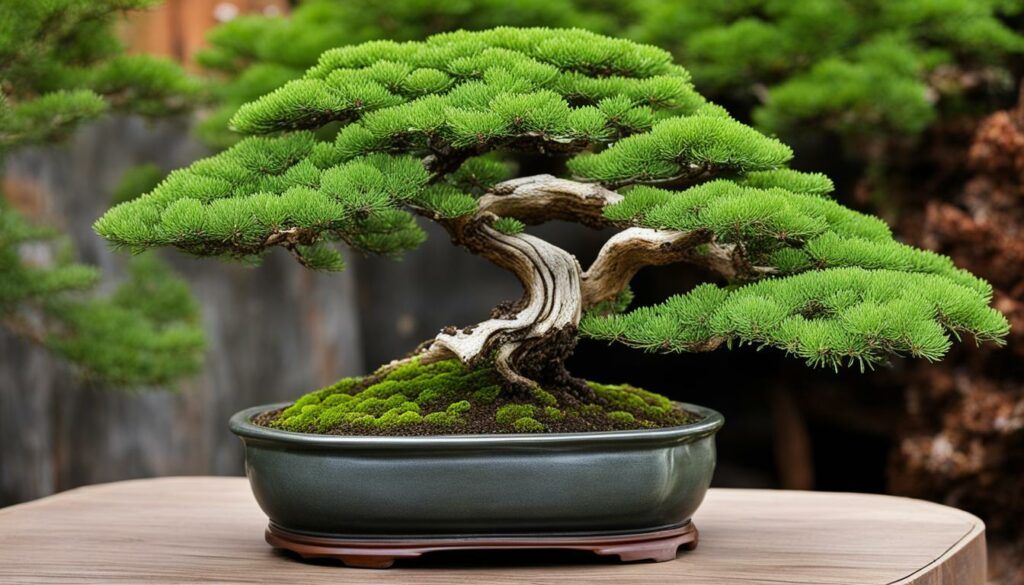
Pine Bonsai Species and How to Tell Them Apart
Pine bonsai species are revered for their bold and resilient natures. The key to differentiating among the pine bonsai varieties lies in understanding their needle clusters and growth patterns. For example, the White Pine typically features soft, flexible needles in groups of five, while the Black Pine has sturdier, darker needles gathered in pairs.
| Characteristic | Juniper Bonsai | Pine Bonsai |
|---|---|---|
| Needle Texture | Smooth and soft | Rough and rigid |
| Needle Color | Silvery to blue-green | Dark green to black |
| Needle Arrangement | Whorled or opposite | In pairs or clusters |
| Growth Habit | Windswept and natural | Upright with conical crown |
| Bark Texture | Smooth to shredding | Scaly and rugged |
Deciduous Bonsai Trees: A Seasonal Challenge
As seasons shift, so do the appearances of deciduous bonsai trees, presenting a unique challenge for enthusiasts keen on seasonal bonsai identification. The ability to recognize and understand the cyclical changes in these trees is crucial for their proper care and appreciation. Let’s delve into the specifics of identifying some of the most beloved species, focusing on their defining traits and the influence of seasonal variations.
Maple Bonsai Trees and Their Distinct Characteristics
Maple bonsai trees captivate with their vibrant foliage and delicate structures. Noteworthy for their maple bonsai characteristics, these trees bear leaves that transition from lush green in spring and summer to spectacular hues of red, orange, and yellow during the fall. Identification markers include their palmate leaves, opposite leaf arrangement, and unique winged seeds, known as samaras, which can be a delight to observe as they develop.
Spotting the Difference with Elm Bonsai Trees
While elms may not boast the bold colors of maples, elm bonsai trees charm with their own merits. Identifiable by their serrated, oval-shaped leaves and a fine network of twigs, elms also undergo a noticeable transition into dormancy. The bark’s texture, ranging from smooth in young specimens to deeply fissured in older ones, along with their tendency to sprout small inconspicuous flowers in early spring, serve as key indicators to seasoned bonsai identifiers.
It’s the recognition of these subtle yet distinctive features that aids in the appreciation and understanding of deciduous bonsai trees. Whether you’re a seasoned practitioner or a novice starting the journey, observing the rhythms of nature within your bonsai is an enriching experience. So embrace the seasonal challenge; let each leaf, bud, and twig guide you closer to the heart of bonsai artistry.
Bonsai Tree Species Identification throughout the Seasons
Seasonal changes offer a dynamic guide to identifying your bonsai tree species. Each season holds key indicators as to the type of bonsai you are nurturing. From the tender shoots of spring growth to the quiet repose of winter dormancy, your bonsai’s response to the seasons provides clues to its identity. Let’s explore how to recognize the various seasonal bonsai changes and what they reveal about the species of your bonsai.
Spring: Observing New Growth
Spring heralds a time of new beginnings and is particularly revealing in bonsai tree species identification. Observe the buds as they swell and burst into new leaves or needles. The shape, size, and color of the new foliage can be greatly telling. Spring growth can also manifest differently in terms of leaf color and flowering patterns, which are species-specific.
Summer: Full Foliage and Tree Vigor
During the summer months, your bonsai is a showcase of summer vigor. It’s this season when the tree is at its fullest, allowing you to study the mature leaves and how the branches are arranged. A bonsai with a dense canopy of lush, verdant leaves might suggest a species that thrives in the vigor of summer.
Autumn: Color Change and Leaf Drop
As days shorten and temperatures cool, autumn color makes its dramatic entrance. Deciduous bonsai varieties display a range of fiery hues before the leaves fall. This color transition provides you with another aspect of species identification as different bonsai trees will exhibit unique shades of yellows, oranges, and reds. Leaf drop times may also give you hints to the particular bonsai species you’re observing.
Winter: Dormancy and Subtle Clues
The quiet of winter dormancy doesn’t equate to a lack of signs. On the contrary, as your bonsai’s foliage thins or disappears, pay attention to the structure and silhouette of the bare tree. The appearance of bark, the arrangement of branches, and even the presence of winter buds can all be subtle yet insightful clues to identifying your bonsai tree species.
Regional Bonsai Varieties and Their Unique Features
As you delve into the world of bonsai, you’ll quickly discover that identifying bonsai trees goes beyond mere aesthetics—it’s about understanding the rich tapestry of geography and climate that shapes each tree. Around the world, regional bonsai varieties have adapted unique features that reflect their origins, offering a glimpse into the cultural and climatic idiosyncrasies that influence their growth and form.
Let’s explore some of these regional varieties and their distinguishing characteristics. This will not only enhance your appreciation of bonsai but will also arm you with knowledge critical for proper care and identification.
| Region | Variety | Identifying Features |
|---|---|---|
| Japan | Japanese Maple (Acer palmatum) | Vibrant foliage coloration, delicate leaves |
| China | Chinese Elm (Ulmus parvifolia) | Small, leathery leaves, fine twigging |
| Mediterranean | Olive Bonsai (Olea europaea) | Silver-green leaves, gnarled trunks |
| North America | Bald Cypress (Taxodium distichum) | Deciduous conifer, feather-like leaves, fluted trunk base |
| Australia | Moreton Bay Fig (Ficus macrophylla) | Large, glossy leaves, robust root structure |
By understanding and recognizing the unique bonsai features characteristic of regional bonsai varieties, you’re better equipped to select and care for bonsai trees that will thrive in your specific environment, thus fostering a harmonious relationship between nature, culture, and the bonsai enthusiast.
Advanced Techniques for Identifying Bonsai Trees
As you delve deeper into the world of bonsai, you may seek more sophisticated methods to ascertain the lineage of your miniature tree. With the advent of advanced bonsai identification techniques, pinpointing the exact species of your bonsai has transcended traditional approaches. Let’s explore how cutting-edge bonsai DNA analysis, combined with bonsai expert guidance, can propel your bonsai recognition skills to new heights.
Using DNA Analysis for Accurate Identification
Bonsai DNA analysis is a groundbreaking technique that involves extracting and examining the genetic material of your bonsai to determine its species with unparalleled accuracy. This scientific approach can be particularly beneficial when the visual cues are ambiguous or when dealing with rare or hybrid species. By collaborating with laboratories that specialize in botanical DNA analysis, you can uncover not just the species, but also the genetic lineage and potential traits of your bonsai.
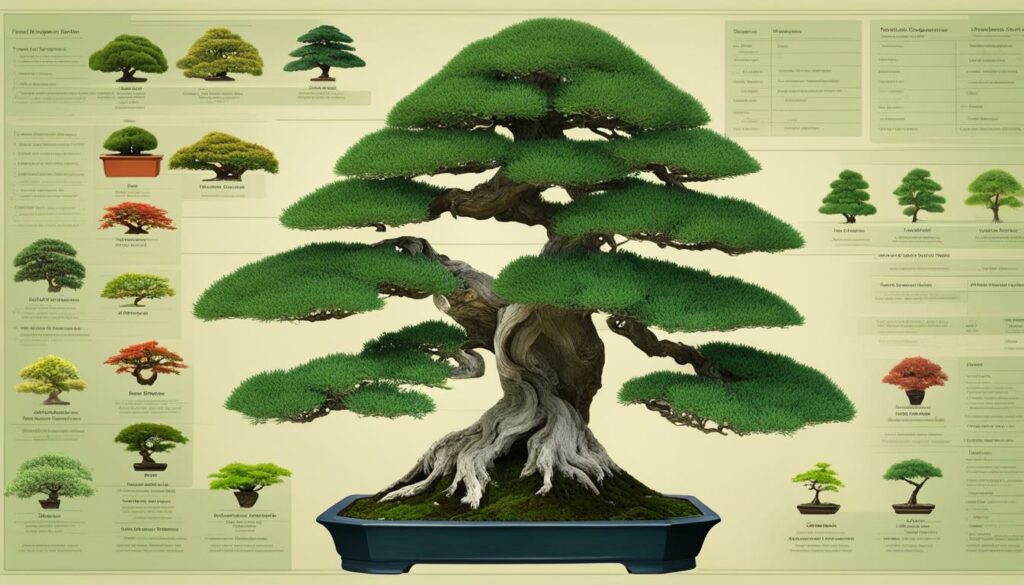
Learning from Bonsai Experts and Masterclasses
Apart from the technical aspects, seeking the mentorship of a seasoned bonsai expert can significantly enhance your understanding and skills in species recognition. These experts often share their extensive knowledge through masterclasses and workshops. Participating in such events grants you the opportunity to gain hands-on experience, witness demonstrations of identification in practice, and receive personalized feedback on your bonsai identification challenges.
The synergy of high-tech analysis and personal tutelage can elevate your proficiency in recognizing the various nuances that define different bonsai species. Embrace these advanced techniques, and watch as the world of bonsai unveils its secrets to you, one species at a time.
Common Misconceptions in Bonsai Identification
When embarking on the journey of identifying bonsai trees, enthusiasts often encounter several misconceptions that can lead to misidentification. It’s essential to clear up these mistakes to enhance your bonsai identification acumen.
One of the most frequent oversights is assuming all small-leaved trees are the same species, or that all bonsai with needle-like foliage must be conifers. These simplifications do not take into account the vast diversity within the bonsai world.
Let’s look at a few common errors:
- Leaf Size Determines Age: Many believe that smaller leaves indicate an older bonsai. However, leaf size is often a result of the species and the cultivation techniques used, rather than age alone.
- Trunk Girth Equals Maturity: While a thick trunk can suggest an older tree, some species naturally have slimmer trunks or have been designed to retain a slender appearance.
- Flower Colors Are Consistent: Assuming that flower colors don’t vary within a species can be misleading. Many bonsai varieties boast a range of flower colors due to hybridization and environmental factors.
Understanding these nuances is crucial when approaching misconceptions in bonsai identification.
| Misconception | Reality |
|---|---|
| Bonsai are simply dwarf plants | Bonsai are regular trees trained to remain small through specific techniques |
| All bonsai trees are miniature | Bonsai comes in various sizes, including some ‘imperial’ size specimens that are quite large |
| Identical care suits all bonsai | Each bonsai species has unique care requirements in terms of light, water, and nutrition |
To avoid these pitfalls, ensure that you thoroughly research and observe the distinctive traits of each species. Be wary of quick assumptions and seek guidance from credible sources when needed.
In conclusion, remember that identifying bonsai trees is a delicate art that combines observation with knowledge. Stay informed, patient, and respectful of each tree’s unique identity to avoid the common misconceptions in bonsai identification.
The Significance of Soil and Pot Choice in Identification
When immersing oneself in the nuanced world of bonsai cultivation, soil type for bonsai and bonsai pot selection are not merely routine decisions—they are integral to both the vitality and the identification of your miniature tree. Expert bonsai enthusiasts will tell you that these choices communicate volumes about the species and its native habitat, guiding you to provide optimal care tailored to your bonsai’s specific needs.
The right soil mix does more than just support your bonsai; it replicates its native environment, influencing everything from moisture retention to oxygen flow. This facilitates not just health and growth but can also be an indicator of the species through species recognition. Contrastingly, the wrong soil can hinder root development and impede nutrient uptake, leading to a less than flourishing bonsai.
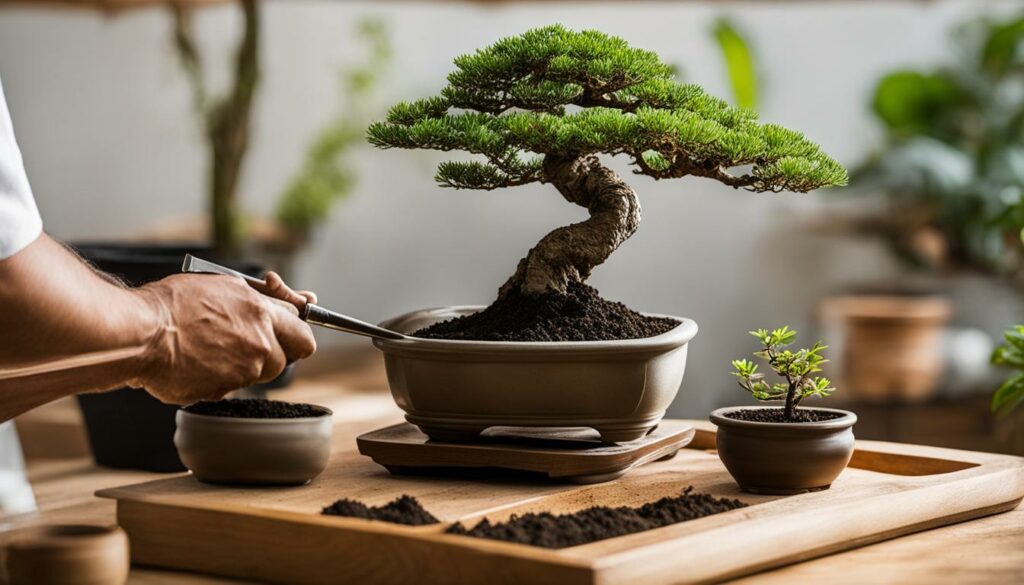
Similarly, the selection of a bonsai pot is more than an aesthetic choice—it’s about understanding the root structure and growth pattern of your bonsai’s species. Different styles and materials of pots cater to different species, influencing not only the health and development of your bonsai but also its presentation.
To help you get started, here is a guide for pairing soil and pots with common bonsai species:
| Bonsai Species | Recommended Soil Type | Preferred Pot Type |
|---|---|---|
| Juniper | Akadama mixed with pumice and lava rock | Unglazed oval or rectangular pots |
| Maple | Kanuma soil for acidic preference | Glazed oval pot with ample drainage |
| Ficus | Universal bonsai soil with organic material | Deep round pot to accommodate strong roots |
| Pine | Conifer mix with good drainage | Unglazed pot with a minimalistic style |
As you delve into the enriching practice of bonsai cultivation, use these insights on soil type for bonsai and bonsai pot selection to enhance your skill in species recognition. Let these elements guide you, not just to a more beautiful bonsai, but to a deeper understanding of the tree before you.
Tips for Documenting and Cataloging Your Bonsai Collection
As a bonsai enthusiast, maintaining a detailed bonsai identification record is key to managing your living art pieces effectively. Whether you’re a novice gardener or an experienced cultivator, documenting your bonsai collection can enhance your understanding of each tree’s needs and help you track their growth and development over time. Here are some pragmatic strategies for cataloging bonsai trees that will preserve the history and progression of your collection.
- Create a file for each bonsai that includes the species name, date of acquisition, age, and source. This basic information will serve as your reference point for all subsequent care and styling decisions.
- Keep a log of care routines including watering, fertilizing schedules, pruning sessions, and any pest or disease treatments. Not only will this serve as a valuable guide for you, but it can also be an essential record for any future caretakers of your bonsai.
- Note any significant changes in appearance, such as leaf color or blooming patterns—traits that are often critical for correct bonsai identification. High-quality photographs are invaluable here and can be organized by date to visualize growth over time.
- Track your bonsai’s shaping journey, noting techniques used during styling sessions such as wiring or grafting. This helps to maintain the intended design of the bonsai as it matures.
Staying diligent in recording these details may seem daunting, but the effort pays dividends in both the short and long term. With a meticulously maintained catalog, not only will you secure the legacy of your bonsai, but you’ll also deepen your connection to the art and science underpinning this ancient horticultural practice.
Developing a Keen Eye for Bonsai Tree Species Identification
Embarking on the journey to master the art of developing bonsai identification skills begins with nurturing a detail-oriented approach. As you learn to appreciate the nuances of your bonsai, you’ll discover the subtle but distinct characteristics that make each species unique. Engaging regularly with your bonsai will not only deepen your connection but also enhance your ability to remember and recognize different bonsai types.
Observation is key. Taking the time to visually examine the leaf patterns, bark textures, and growth habits of your bonsai will lay a solid foundation for your bonsai types recognition abilities. Joining a community of fellow enthusiasts and learning from experienced growers can exponentially increase your knowledge. They can offer insights that books and online resources may not cover, providing real-life examples and troubleshooting that speak to the complexity of each species.
View identification as a form of ongoing education. By involving yourself in the various aspects of bonsai care—from attending workshops to participating in forums—you’ll continue to sharpen your identification skills. The mastery of bonsai identification does not happen overnight. It’s a progressive art that intertwines scientific understanding with an aesthetic eye. Reflect on this as you tend to your bonsai, and enjoy the process of learning, identifying, and cultivating these living works of art.
Conclusion
As we conclude our journey through the delicate and meticulous world of bonsai tree species identification, we recognize the depth of engagement and dedication required to master this facet of the art of bonsai. It is clear that the ability to identify the myriad of species in the bonsai garden is not merely a function of keen observation—it is a doorway to understanding the heritage and essence of this ancient practice. The skill set you develop in mastering bonsai identification does more than enhance your practical care for these miniature trees; it forges a deeper connection with the very roots of bonsai culture.
Through continuous learning and consistent practice, you can aspire to achieve a level of proficiency that transcends basic care, allowing for a more nuanced and informed approach to cultivating your bonsai. The time-honored traditions and modern techniques outlined throughout this guide serve as your compass as you navigate the intricacies of leaf shapes, seasonal changes, and regional characteristics that define each unique species.
The pursuit of knowledge in bonsai tree species identification is a lifelong endeavor filled with moments of awe and understanding. Bear in mind that each step taken to learn more about your bonsai enriches not only your own experience but also sustains the legacy of the art of bonsai for future generations to cherish. Embrace this path with curiosity and patience, and you will discover that the world of bonsai offers boundless opportunities for growth—both for the trees under your care and for your own development as a cultivator of nature’s living sculptures.
FAQ
What is the importance of bonsai tree species identification?
Identifying bonsai trees is crucial for enthusiasts as it aids in providing the proper care and styling tailored to each species, ensuring their health and aesthetic appeal. Recognizing different species also enhances appreciation and allows for successful cultivation of these miniature trees.
How can I tell different bonsai trees apart?
To distinguish between bonsai species, you should look at characteristics such as trunk and bark textures, leaf shapes, the presence of flowers or fruit, and growth patterns. Seasonal changes can also provide clues for identification.
Which bonsai tree varieties are the most popular?
Some of the most popular bonsai varieties include Ficus, Juniper, and Maple bonsai. Each has distinctive features that make them beloved among bonsai cultivators.
How do the seasons affect bonsai tree species identification?
Seasonal changes can significantly impact the appearance of bonsai trees. Observing new growth in spring, full foliage in summer, color change and leaf drop in autumn, and the subtle indicators of dormancy in winter can all help in species identification throughout the year.
Can the type of soil and pot impact bonsai species identification?
Yes, the choice of soil and pot can sometimes indicate a bonsai’s species, as different types require specific conditions for optimum health and growth. These elements can therefore provide additional insights into identifying your bonsai.
How do flowers and fruit aid in bonsai tree species recognition?
The presence, size, color, and seasonal appearance of flowers and fruit are distinctive features that can help distinguish between different bonsai tree species.
Why is documenting and cataloging your bonsai collection useful?
Keeping a documented catalog of your bonsai collection helps in tracking the growth, health, and development of each tree. It also assists in species identification and management of your collection over time.
What advanced techniques can I use for accurate bonsai tree identification?
Advanced techniques such as DNA analysis can provide precise identification, and learning from bonsai experts or attending masterclasses can greatly enhance your ability to recognize different species.
What are common misconceptions in bonsai identification that I should be aware of?
Some misconceptions include the belief that all bonsai trees are miniature versions of their full-sized counterparts and that certain species can only be grown in specific styles. Educating oneself and learning to recognize different species accurately helps dispel these myths.
How can I develop a keen eye for identifying bonsai tree species?
Developing keen observation skills involves regularly engaging with your bonsai, learning from experienced growers, and utilizing resources to understand species characteristics. Over time, you will be able to identify species more readily as you become familiar with their unique attributes.
